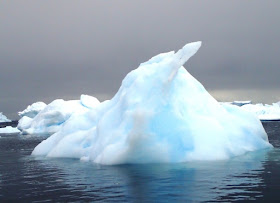The whole scale of Antarctica is so awesome that you
can’t help but feel like just a tiny, insignificant part of the world when
cruising beside enormous icebergs and sailing beside the huge ice sheets that
cover most of the land mass. Here are a few more icebergs from our recent Antarctic journey with Quark Expeditions.
But the magical part is viewing these beautiful
creations of nature, especially when the sun is glistening off the ice or
reflecting inner surfaces to produce a variety of effects and colors. Icebergs can
contain shades white, blue, brown, green, and more—and their shapes are
constantly changing. Icebergs can carry rocks and gravel within the ice, which
may give them dark gray or black sections.
In the warming sun, the ice expands and can give off
a variety of creaking or groaning sounds—or the loud bang and splash of a chunk
breaking off (calving). A large berg can even create a tidal wave that washes
up on shore or moves among other bergs causing even more noises.
Icebergs may break off from glaciers (more common in
the Arctic) or an ice shelf—the most likely means of formation in Antarctica.
It’s estimated that 50 to 99 percent of an iceberg lies beneath the surface,
which is totally hard to imagine. The amount below water is related to how much
air is trapped in the ice, which affects its buoyancy.
Icebergs are composed of fresh water that started as
snow accumulating over hundreds, even thousands, of years. The amount of air trapped
between flakes and ice crystals determines layers, striations, and colors, so
every iceberg is different.
Mostly icebergs sit in the ocean bobbing around. Eventually they melt and erode, the balance-point changes, and the berg may
crack or split. The result is an indescribably beautiful canvas of continually
changing masses to enjoy but respect.Photos by Larry and Beverly Burmeier






No comments:
Post a Comment